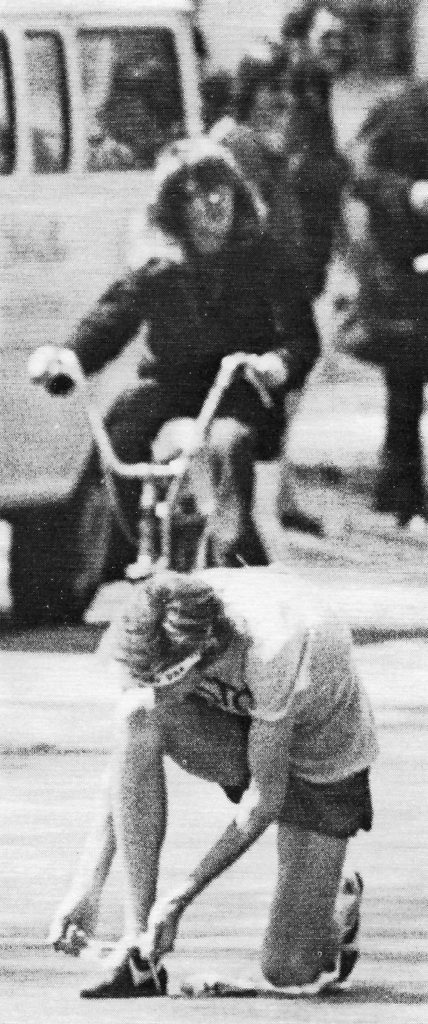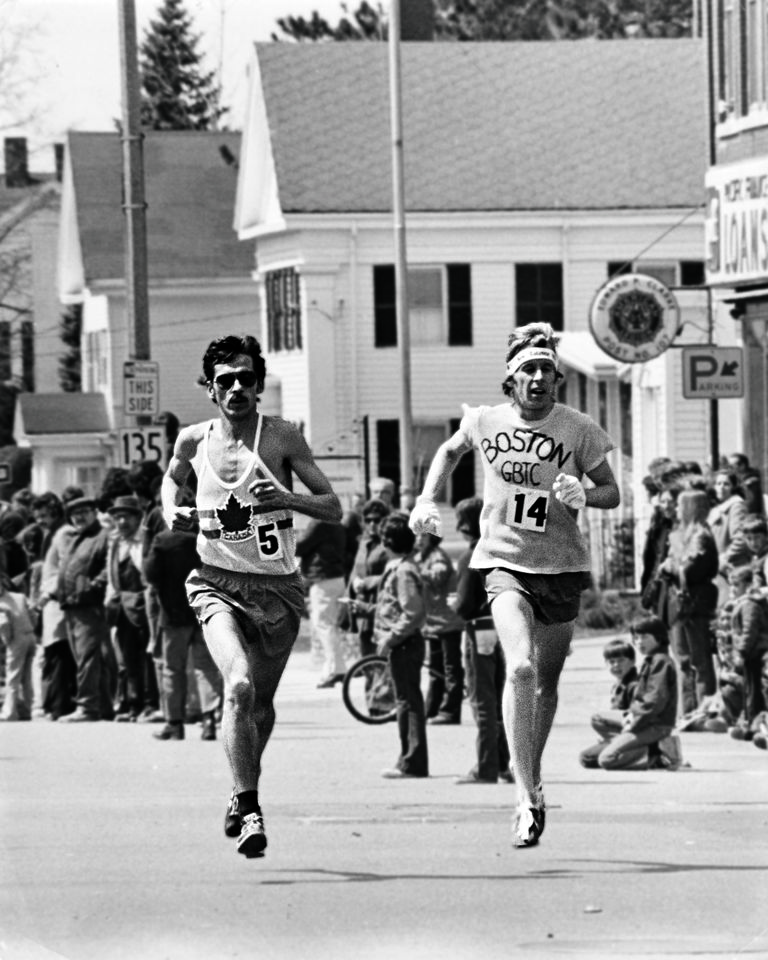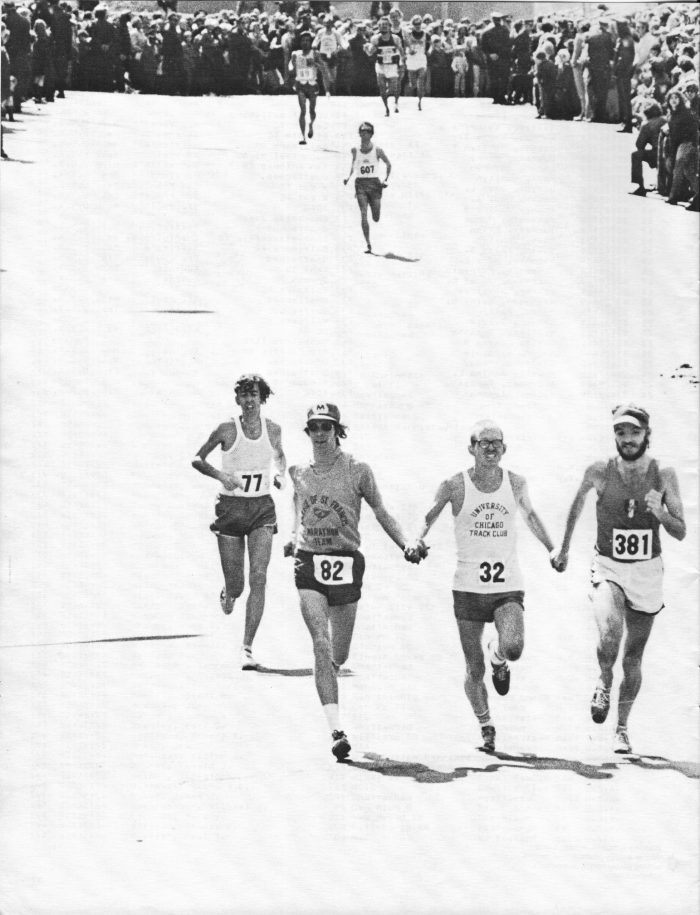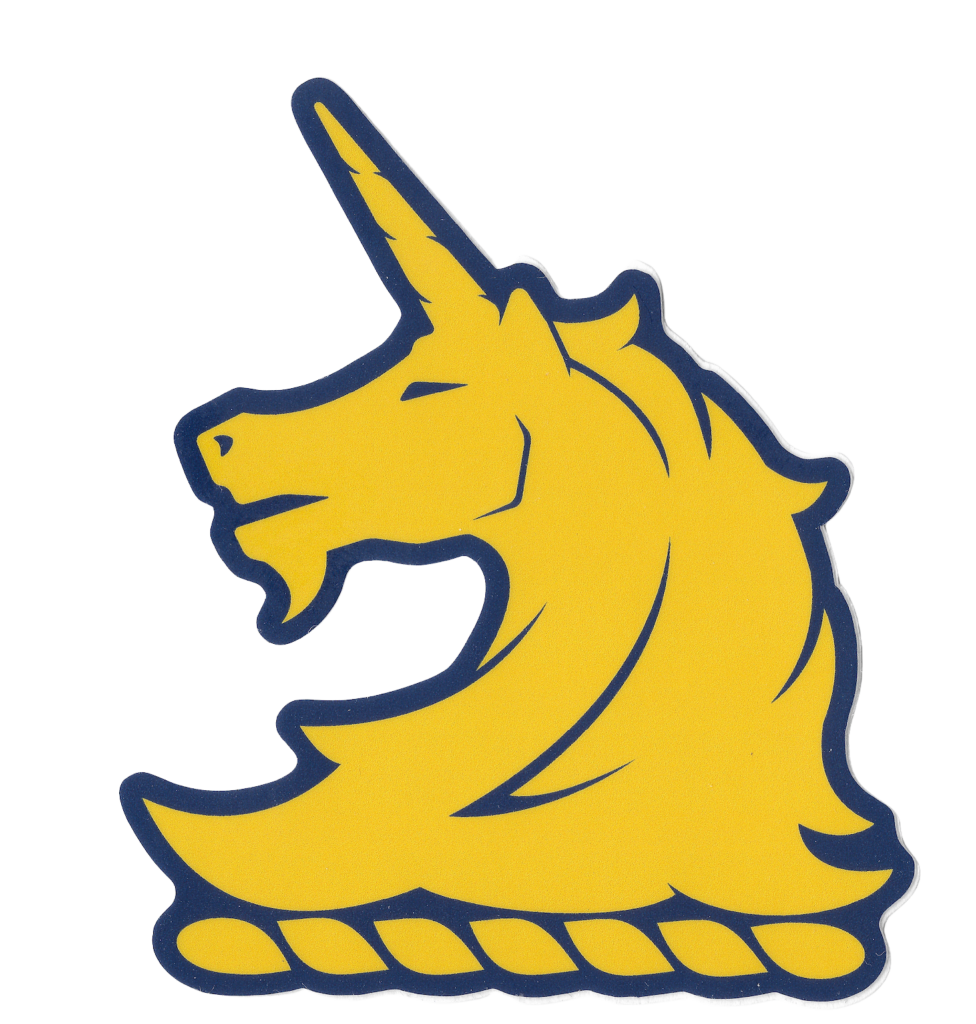
79th Boston Marathon
A Spot On The Second Row
There are days when everything just seems to fall in place. For me, Monday, April 21, 1975, was one such day, although there was a good bit of worrying on my part as it was unfolding.
After the debacle
that was my first Boston race (1973), I bounced back pretty quickly. Six weeks later I was out of the army and, aided by the GI Bill, heading back to grad school to resume life as a “professional student.” Six months later, I cut over 20 minutes off my March BQ time, a good enough performance for tenth place in the first marathon ever run in the nation’s capital.
I decided to skip Boston in ’74 and concentrate on the AAU Championship, held in early June at the Yonkers NY Raceway. Most of that race was run in the rain, and as the marathon course was laid out to include multiple loops of the half mile standardbred harness racing dirt surface, there was quite a bite of sloppy track involved. I don’t know which I enjoyed more, knocking another five minutes off my marathon PR, or the honor of competing on the same infamous track where Seabiscuit and automobile driver Barney Oldfield had previously raced.
However, as the Boston Marathon is so closely linked to Patriots’ Day in Massachusetts, and as 1975 marked the bicentennial of Paul Revere’s midnight ride and the start of the American Revolution, the urge to return was too strong for me to resist. Apparently a number of other folks felt the same way as the April 20th Boston Globe reported “the largest marathon field ever” – 2,392 entrants.

Four of the eventual top five finishers are visible at the head of the pack: Tom Fleming (#2), Thomas Howard (#27, with the “7” obscured here), Steve Hoag (#6), and Ron Hill (#1). Don Kennedy (#P49, 15th place) who got me a spot on the second row at the start is seen between Fleming and Finland’s Ari-Pekka Gylling (U98, who finished [no pun intended] in 13th place).
Moving up even faster than I was falling back, and barely visible in his New Balance headband, is winner William H. Rogers, who was kind enough to autograph this photograph four decades late. The Rev. Sean Healy, #23 and a 2:27 marathoner, will tire at the end and I will beat him by two seconds…
Back home we would have called the day “brisk.”
By mid-day, the fifty degree high temperature would turn out to be great marathon running weather, but early on, combined with a 21-mph wind (gusting to 35mph) that made the temp feel ten degrees colder, it did not promise being good standing-around-in-your-shorts weather.
However, back in these ancient pre-chip days, every second you lost getting to the starting line after the gun sounded was a second gone forever, and with almost 2,400 entered, that added up to a lot of lost time for those runners at the back of the pack. So, in spite of the cold weather, I was anxious to get over to the start and queue up for the race.
As I made my way towards Hayden Rowe Street with a small handful of other runners from North Carolina, I had the great good fortune to be in the company of Don Kennedy. Donnie ran track and cross country for Appalachian State in the late 1960s. By 1973 he had developed into the #7 U.S. marathoner, and in 1974 Donnie finished Boston in in 17th place – 2:20:17.
Well before reaching the starting line, we ran into the back end of a crowd of runners. Resignedly, I was about to join this group before I lost any more distance from the front, when Donnie waved me on up the sidewalk. I followed him up a driveway to the backdoor of a small house, where after a knock he was greeted like the Prodigal Son: “Welcome back; Good to see you; Come on in!”
We joined a number of runners in the living room, where after signing their marathon guest book, we were offered all kinds of refreshments. Thumbing through the guest book, it appeared hosting marathon runners was a long standing family tradition. It was like old home week, with folks recalling races past, and sharing what they’d been up to in the past year. What a relaxed (and warm) way to await the start of the race.

Still, I Was Anxious About The Ever Growing Crowd Outside.
Finally about ten minutes before noon, Donnie said it was time to go. We gave our thanks and headed back out into the chilly wind. I was about to turn down the sidewalk and head towards the end of the now even longer line of runners, when Donnie surprised me once again by turning towards the front of the line!
Just as quick,
we cut down a side road to the next street over, where after three more right angle turns, I found myself back on Hayden Rowe Street, only this time ahead of the starting line. Several of the elite runners were warming up on this uncrowded residential road, and I found myself striding beside Ron Hill, the 1970 winner and current course record holder (2:10:30).


This was pretty heady stuff,
being in the company of all these single and low double digit numbered runners. I should have been back with the much larger group of runners sporting either a three digit number, or further down the pecking order, a letter and a number, in my case, O16. A number of BAA officials were at the start line assigned to keep interlopers from sneaking up to the start. I hoped my number looked more like a “Zero-16” than an “Oh-16,” and thus low enough to qualify me to be at the front.
Just as everyone was being herded back behind the starting line, one official decided he didn’t like my looks, and started heading my way. Donnie ran some interference for me, and the man gave up, deciding it was too late to do anything anyway, and letting me go.
And so I found myself pushed back across the start line, literally rubbing shoulders with Tom Fleming, Boston runner-up in 1973 and 1974. At the last second I decided I didn’t have the nerve to start on the Boston front row, so I ducked in behind those runners toeing the mark, and as the gun was fired, I had a spot on the second row…

My Immediate Thought
was how to survive this stampede of runners whose pace today was going to be a minute or more per mile faster than mine. I somehow managed to avoid being trampled as dozens of runners sped by, even making it through the sharp right-hand turn about a quarter mile after the start. The surge of the 200 or so speed demons was now gone, but I was still in good company, and on my way to Boston!

If you have seen photos of the 1975 race,
they have most likely included pictures of the eventual winner Bill Rodgers’s unprecedented number of stops along the way: four times to accept cups of water, and once or twice to retie a shoelace. [His brand new Nike shoes, gifted by Steve Prefontaine, turned out to be a size or two too large, and required some in-race readjusting.]
The previous fall I had had the similar embarrassment of a loose shoelace shortly after the start of the D.C. marathon, which caused me an unnecessary delay. Since then, one of the last details in my pre-race ritual was to check my shoes. Today I had on my most comfortable pair of very-well-broken-in Adidas. When I knelt to double check the laces, to my chagrin I discovered, while the laces were tight, the stitching on the heel box was coming undone. I could just picture my shoe coming apart at the top of the Newton hills! A shoe malfunction became my constant worry over the next two and a half hours. But other than that, my race was remarkably without incident.



The Weather Was Perfect,
with afternoon temps barely reaching the mid 50s, and a strong northwest quartering wind, with favorable gusts that became known as the Boston “tail gale.” I’m not sure if I ever had an easier feeling race. For much of the run I felt like I was just coasting. I spent a good bit of time worrying if I should be pushing my pace, but I hated to risk losing what I knew would be (for me) a good time. What if I pushed myself beyond my training and fell apart trying to shave off a few seconds. And then there was the matter of that loose stitching: Would faster steps make my shoe worse???
Two years before, I had staggered over Heartbreak Hill. Today I hardly noticed as I passed the crest. In the last few miles, I continued to pass a few more runners than were passing me. And in the last straightaway to the finish line and the Prudential Center, I remember being surprised by the wide open expanse of Boylston Street, and how many people were packed around the edges.
My time was a PR 2:36:27. Another 30 seconds would have put me in the top 200 places, rather than 208th, and I regretted not pushing my pace up just a second or two in the middle miles. But I was pretty confident I’d be back soon to try Boston again.
However, although I ran later races of which I am equally proud (such as a sub-three hour 3rd place at Grandfather Mountain), I never again bettered 2:37:00 in the marathon, and it would be 38 years before I again registered for Boston.


Twenty-Three Seconds And Ten Places Behind Me,
Ed Steingraber (#82), Ken Young (#32), and Tim McLoone (#381) join hands on the run to the finish. After the claustrophobic crowds lining Hereford Street, coming onto Boylston’s wide open spaces with only a handful of fellow runners was an amazing experience. (Boston Globe Photo)
MIT grad Nick DeWolf, a keen and prolific photographer, documented Patriots Day 1975. After taking pictures of Arthur Fiedler directing the Boston Pops, and of local politicians standing nearby, DeWolf made his way toward the marathon finish line, where just before getting serious with his camera, his inadvertent trigger finger captured me (green shorts), catching my breath after my final sprint down Boylston Street.
I was able to locate this shot and a few others on Flickr, thanks to his son-in-law, who has scanned DeWolf’s complete archive. A half century later, it’s the only photo I have of myself at the Boston finish for either ’73 or ’75.
One-One in head-to-head matchups
Although he got his revenge in 1975, four decades later Bill Rogers still knows (as my t-shirt attests) I out-ran him in 1973.
© 2021 All Rights Reserved.
